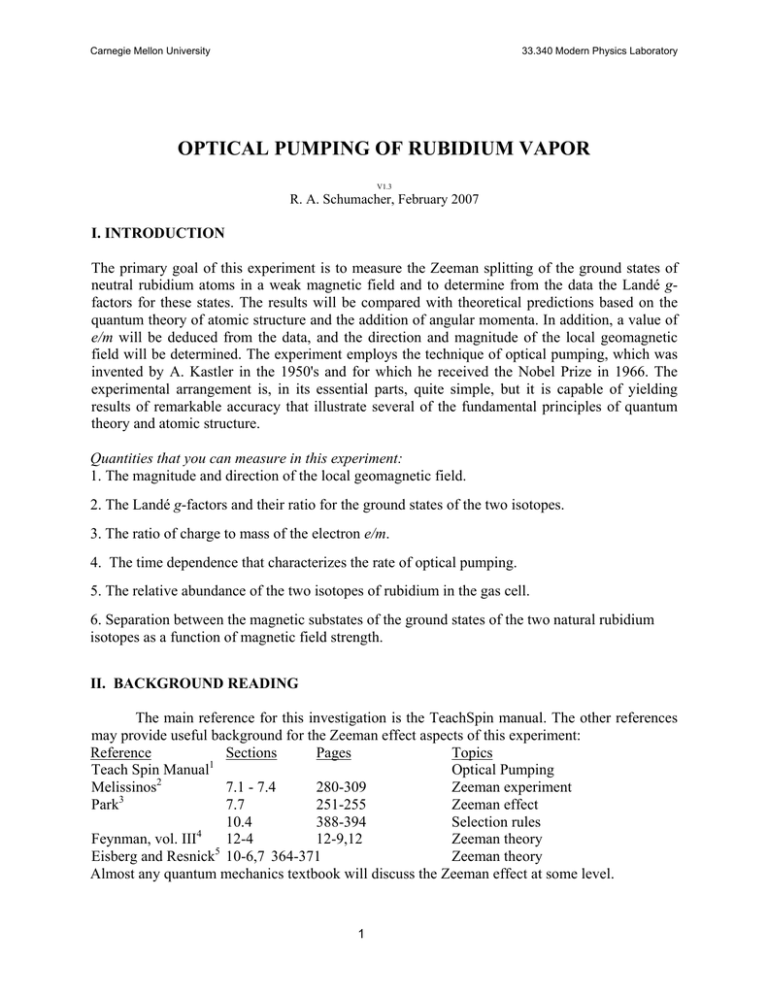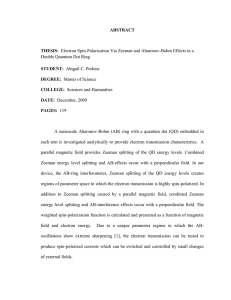The Zeeman Effect
advertisement

Carnegie Mellon University 33.340 Modern Physics Laboratory OPTICAL PUMPING OF RUBIDIUM VAPOR V1.3 R. A. Schumacher, February 2007 I. INTRODUCTION The primary goal of this experiment is to measure the Zeeman splitting of the ground states of neutral rubidium atoms in a weak magnetic field and to determine from the data the Landé gfactors for these states. The results will be compared with theoretical predictions based on the quantum theory of atomic structure and the addition of angular momenta. In addition, a value of e/m will be deduced from the data, and the direction and magnitude of the local geomagnetic field will be determined. The experiment employs the technique of optical pumping, which was invented by A. Kastler in the 1950's and for which he received the Nobel Prize in 1966. The experimental arrangement is, in its essential parts, quite simple, but it is capable of yielding results of remarkable accuracy that illustrate several of the fundamental principles of quantum theory and atomic structure. Quantities that you can measure in this experiment: 1. The magnitude and direction of the local geomagnetic field. 2. The Landé g-factors and their ratio for the ground states of the two isotopes. 3. The ratio of charge to mass of the electron e/m. 4. The time dependence that characterizes the rate of optical pumping. 5. The relative abundance of the two isotopes of rubidium in the gas cell. 6. Separation between the magnetic substates of the ground states of the two natural rubidium isotopes as a function of magnetic field strength. II. BACKGROUND READING The main reference for this investigation is the TeachSpin manual. The other references may provide useful background for the Zeeman effect aspects of this experiment: Reference Sections Pages Topics 1 Teach Spin Manual Optical Pumping Melissinos2 7.1 - 7.4 280-309 Zeeman experiment 3 Park 7.7 251-255 Zeeman effect 10.4 388-394 Selection rules Feynman, vol. III4 12-4 12-9,12 Zeeman theory Zeeman theory Eisberg and Resnick5 10-6,7 364-371 Almost any quantum mechanics textbook will discuss the Zeeman effect at some level. 1 Carnegie Mellon University 33.340 Modern Physics Laboratory III. THEORY OVERVIEW Read Sections 2.A through 2.E, the “Theory” sections of the TeachSpin manual. You can skip Section 2.F upon first reading. Based on your reading and on Figure 1 in this document, do the exercises below. Figure 1 shows schematic energy level diagrams for the ground and lowest excited states of 85Rb and 87Rb in a weak magnetic field, showing how the ground and first excited electronic states can be imagined to split into successive sublevels as the various interactions are “turned on”. The energy scale is grossly distorted in order to display the hierarchy of structure in one figure. In fact, the separations between the Zeeman levels in a weak external field of ~1 Gauss are ~108 times smaller than the separation between the unperturbed 5S and 5P levels. Parts (d) of the figures represent the specific level structures with which we will be dealing in this experiment. In Figure 1 (a) shows the interaction between the outer electrons and the combined Coulomb field of the nucleus and inner closed-shell electrons, giving rise to states specified by the principal quantum numbers and the orbital angular momentum quantum numbers (5S, 5P) of the outer electrons, differing in energy by ∆E~100 eV. (b) interaction between the magnetic moments associated with the spin and orbital angular momenta of the outer electron(s), giving rise to “fine structure” substates differing in energy by ∆E~10-3 eV. (c) interaction of the total electronic magnetic moment and the magnetic moment of the nucleus, giving rise to “hyperfine structure” substates with ∆E~10-6 eV. (d) interaction between the total magnetic moment of the atom and the external magnetic field. Transitions among the various energy levels can occur under a variety of circumstances, which include the following of particular interest in this experiment: 1) Electric dipole transitions between the 5S and 5P states: i) either absorptions or stimulated emissions induced by interactions with optical frequency photons having close to the energy difference of two atomic states. ii) spontaneous emissions: electric dipole transitions are restricted by the selection rules ∆S = 0, ∆J = 0 or ±1, ∆L = 0, ±1, ∆f=0 or = ±1 except not 0→0, and ∆mf = 0 or = ±1. 2) Magnetic dipole transitions between magnetic substates induced by radio frequency photons with energies near the energy difference of two Zeeman levels. The selection rule is ∆mf = ±1. 3) Collision-induced transitions between magnetic substates. 2 Carnegie Mellon University 33.340 Modern Physics Laboratory hydrogenic state electron spin-orbit electronnuclear fine structure hyperfine structure 2 Zeeman splitting P3/2 mf 5P +3 f=3 2 −3 P1/2 gj = 2/3 −2 f=2 typical optical transition (λ~794.8 nm) +2 D1 +3 f=3 5S 2 −3 S1/2 gj = 2 typical RF transition (~0.5 MHz/Gauss) −2 f=2 +2 (a) hydrogenic state (b) (c) electron spin-orbit electronnuclear fine structure hyperfine structure 2 (d) Zeeman splitting P3/2 mf 5P −2 f=2 2 +2 P1/2 gj = 2/3 −1 +1 f=1 typical optical transition (λ~794.8 nm) D1 −2 f=2 5S 2 +2 S1/2 gj = 2 (a) −1 +1 f=1 (b) (c) typical RF transition (~0.7 MHz/Gauss) (d) Figure 1: Energy levels (not to scale) of 85Rb (I=5/2) [top] and 87Rb (I=3/2) [bottom] as successively weaker interactions are turned on (from a to d). (After Ref 7). 3 Carnegie Mellon University 33.340 Modern Physics Laboratory Write out the solutions to these exercises in your laboratory notebook. Exercises: 1. With reference to Figure 1 of this guide, estimate the energy differences (order of magnitude), in eV, between each of the following pairs of states of 85Rb: a. 5 2S ½ − 5 2P ½ b. 5 2P½ − 5 2P 3/2 c. 5 2S½ (f= 2) − 5 2S½ (f=3) d. 5 2S½ (f= 2, mf = − 1) − 5 2S½ (f=2, mf =0) in a magnetic field of 1 gauss. 2. Derive the Landé g-factors for the ground state of the two rubidium isotopes using either the vector model or matrix mechanics for the addition of angular and magnetic moments. 3. In thermal equilibrium at 320 K how many atoms in a mole of rubidium would one expect to find in the 5 2P ½ state? What is the difference in the population of the lowest and highest magnetic substate of the ground state in a field of 1 Gauss at that temperature? 4. How do you make a beam of circularly polarized light? 5. If the earth's field were that of a magnetic dipole at the center and parallel to the rotation axis, then what would be the direction of the field at the latitude of Pittsburgh? 6. What fractional contributions does the nucleus make to (a) the total angular momentum and (b) the total magnetic moment of a rubidium atom? 7. If you are taking the Advances Quantum Physics course, derive Equation 2B-6. 8. If you are taking the graduate level Quantum I course, derive Equation 2B-8. 4 Carnegie Mellon University 33.340 Modern Physics Laboratory IV. EXPERIMENTAL APPARATUS Read Section 3.A through 3.F, “Apparatus”, of the TeachSpin Manual. This is best done while sitting next to the apparatus so you can examine and adjust each part. Exercises: 9. What is the purpose of the buffer gas in the rubidium cell? V. EXPERIMENTAL PROCEDURES AND GOALS There is a wealth of possible measurements that can be made with this apparatus. Follow your own interests, in consultation with the instructor. The following general results can be obtained for this experiment: 1) Find the “Zero-field” transition. From this, determine the magnitude and direction of the Earth’s magnetic field at the location of the apparatus. Use the Helmholtz coil equations for the applied magnetic field in order to compute the applied field more precisely than the manual allows and make a proper uncertainty estimate. Compare your measurement to a model in which the Earth has a perfect dipolar field that you compute for the latitude of your apparatus. The TeachSpin manual explains how the apparatus works. 2) Measure the g-factors for the two Rubidium isotopes in the cell. Do this by basically following the steps in Experiment 4.B “Low field resonances” in the TeachSpin manual. Compare your results, including your estimated uncertainties, with the theoretical predictions for the g-factors of these states. Then, from the very same data set, take the point of view that the values of the g-factors are precisely known from theory and compute the value of e/m, the ratio of charge to mass of the electron. 3) Apply a modulating square wave pulse to the RF signal, and use this to explore the time scale and time dependence of how the atomic system gets optically pumped. What is the functional form of the time dependence? What number(s) characterize(s) it? How does it depend on the intensity of pumping light and other factors? If time permits, continue with the following measurements: 4) Do Experiment 4.C “The Quadratic Zeeman Effect” in the TeachSpin manual. The stepby-step instructions in the Appendix may be helpful to find the signals. 5) Do Experiment 4.D “Transient Effect” in the TeachSpin manual. This is actually the study of Rabi oscillations. Ask the instructor for a supplemental handout on this topic: the TeachSpin manual is inadequate in explaining this phenomenon. 5 Carnegie Mellon University 33.340 Modern Physics Laboratory References 1) Teach Spin Manual “Instructor’s Manual” Copyright 2002. 2) A. C. Melissinos, Experiments in Modern Physics, Academic Press, New York, 1966. 3) David Park, Introduction to the Quantum Theory, McGraw Hill, 1974. 4) R. Feynman, R. Leighton, M. Sands, Lectures on Physics, vol. III, Addison-Wesley, 1965. 5) R. Eisberg and R. Resnick, Quantum Physics, 2nd ed. Wiley, 1985. 6) P. R. Bevington and D. K. Robinson Data Reduction and Error Analysis for the Physical Sciences, McGraw Hill Book Company, New York, 1992. 7) MIT Department of Physics lab manual “Optical Pumping of Rubidium Vapor”, 24Jan91. 6 Carnegie Mellon University 33.340 Modern Physics Laboratory Appendix: How to Find the Transitions in an Intermediate Magnetic Field Set control panel and function generator as follows: RF Output level; 150mVp-p RF Amplifier on panel; 3 on dial Gain; 20x10 Time Constant; 100ms Sweep time; 20 seconds Set oscilloscope: Ch1 is connected to Recorder Output Ch2 is connected to Detector Output DISPLAY → WAVEFORM DISPLAY → Adjust Persist Time by turning the knob on top. DISPLAY → XY DISPLAY Ch1VsCh2 → Select Triggered XY, Ch1(X) versus Ch2(Y), Ref1(X) versus OFF(Y) I. Finding the signals of the isotopes 1. Set the main horizontal field and sweep field (“Range” and “Start Field”) to zero. Turn “Recorder Offset” to the left until it stops. 2. Adjust the scales of the oscilloscope appropriately (Ch1 5.00V, Ch2 500mV). 3. Increase “Start Field” until you find the zero-field transition. 4. After passing the zero-field transition, increase the main field slowly to locate the transition point for Rb87. Note that the GALVANOMETER on the console may be useful at this stage. 5. In order to find the next transition point (Rb85), increase “Start Field” a little so that you can see the dip in a different position on the screen (or you may vary “Persist Time”). 6. Again, increase the main field until you find the transition point (Rb85). II. Finding the Zeeman split transitions (for I-4, or I-7) 1. To check the range of the transition, sweep around the transition using “Start Field”. 2. Center the transition point using “Recorder Offset”. Sweep around the resonances by adjusting “Start Field” and “Range”. 3. Try smaller scales for Ch1 and Ch2 and repeat Step. 2 if necessary. 4. Repeat Step. 3 until you can clearly see the resonances (tip: “Reset” the sweep field and locate the start field before the resonances and then “Start” again). 5. A low frequency may not yield clearly resolved resonances (Why?). Go to a higher frequency. 7



